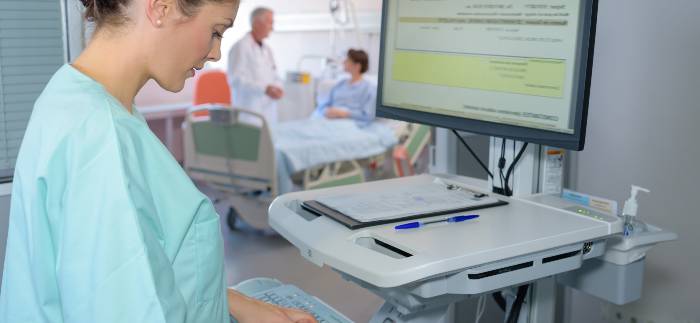Workstations on Wheels: Contamination Patterns Show Arm Used for Moving Carries Highest Bioburden
The bioburden disparities among the various locations sampled could mean HCWs are not practicing proper hand hygiene before using or moving WOWs. It could also reflect the number of touches or a discrepancy in cleaning methods.
(Adobe Stock)

Hospitals rely heavily on portable medical equipment, including workstations on wheels (WOWs). However, these machines are prone to contamination by health care worker (HCW) hands and could potentially serve as fomites in the transmission of health care–associated infections (HAIs).
In an effort to glean more knowledge into potential contamination associated with WOWs, a team of investigators at Central Texas Veterans Healthcare System conducted a longitudinal assessment of contamination patterns on the equipment. Findings were presented in a poster at the Association for Professionals in Infection Control and Epidemiology (APIC) 2022 Annual Conference, held June 13-15, 2022, in Indianapolis, Indiana.
“Periodic disinfection of equipment is required in most hospitals, but multiple surfaces on an equipment may not be adequately disinfected all the time. In addition, the complexity of demands on staff may limit their ability to properly disinfect an equipment,” the research team reported. “The purpose of this study was to determine if current disinfection practices were effectively managing bioburden on WOWs on our hospital wards.”
Using press plates, investigators collected bioburden data from 10 WOWs on each of the 3 units in the hospital over a 4-week period, assigned at random. Samples were taken 4 consecutive days per week (Monday-Thursday) at 3 different time points (9AM, noon, and 3PM). Specific WOW areas sampled included the keyboard, mouse, arm, and tray. Investigators calculated aerobic bacterial colony counts after 24 hours of incubation and used Bayesian multilevel models to estimate the mean bioburden and compare it across locations sampled.
Technicians planned to collect a total of 480 samples, although 28 were lost because the portable medical equipment was in use at the time or unable to be found. After modeling, the estimated mean colony count and 95% UI for press plates takes from WOWs was 29.2 (range, 16.1–51.1) counts.
Estimated mean colony counts were much higher for the arm of the WOW (58.8 [range, 35.2–91.2]) compared with the keyboard (24.7 [range, 14.5–37.2]), the tray (17.0 [range, 10.0–26.4]), and the mouse (12.5 [range, 7.4–19.3]).
“The IRRs for keyboard compared to arm was 0.43 (0.32–0.55), for tray compared to arm was 0.29 (0.22–0.38), and for mouse compared to arm was 0.22 (0.16–0.29),” investigators reported.
The bioburden disparities among the various locations sampled could mean a number of things. It could mean HCWs are not practicing proper hand hygiene before using or moving WOWs. It could also reflect the number of touches, a discrepancy in cleaning methods, or differences in where individual users touch WOWs the most.
“It is also possible that the differences in bioburden levels among these locations is due to the sampling process rather than the result of the bioburden accumulation process, as the keyboard and mouse may be more difficult to sample with a press plate,” the research team concluded. “The correlation of bioburden to HAI transmission was not studied here so the significance of bioburden alone in the absence of HAI monitoring is uncertain.”
Show, Tell, Teach: Elevating EVS Training Through Cognitive Science and Performance Coaching
April 25th 2025Training EVS workers for hygiene excellence demands more than manuals—it requires active engagement, motor skills coaching, and teach-back techniques to reduce HAIs and improve patient outcomes.
The Rise of Disposable Products in Health Care Cleaning and Linens
April 25th 2025Health care-associated infections are driving a shift toward disposable microfiber cloths, mop pads, and curtains—offering infection prevention, regulatory compliance, and operational efficiency in one-time-use solutions.
Phage Therapy’s Future: Tackling Antimicrobial Resistance With Precision Viruses
April 24th 2025Bacteriophage therapy presents a promising alternative to antibiotics, especially as antimicrobial resistance continues to increase. Dr. Ran Nir-Paz discusses its potential, challenges, and future applications in this technology.